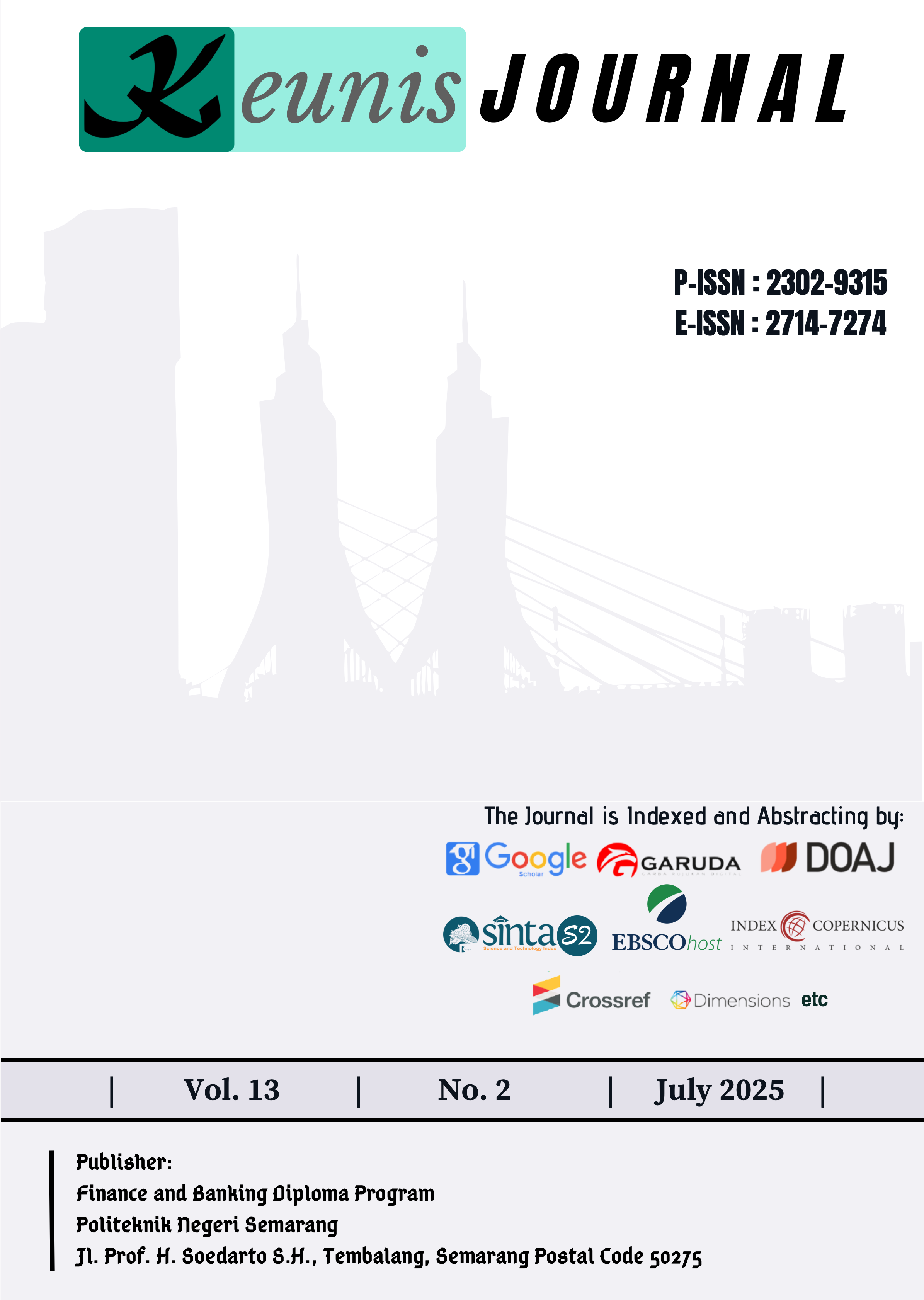Factors Affecting The Level Of Financial Inclusion: A Comparative Study Of Tanzania, Kenya And Uganda
DOI:
https://doi.org/10.32497/keunis.v13i2.6284Keywords:
Financial inclusion, LASSO, Digital finance, Gender, Economic development.Abstract
This research examined the comparative characteristics affecting financial inclusion in Tanzania, Kenya, and Uganda. Despite Tanzania's robust economic development, its degree of financial inclusion remains inferior to that of its neighboring nations, Kenya and Uganda. The provision of accessible financial services to underrepresented people is essential for poverty alleviation and economic growth. This study used cross-sectional micro-level data from the Global Findex Database survey waves conducted in 2011, 2014, 2017, and 2021. The Least Absolute Shrinkage and Selection Operator (LASSO) post-selection inference technique was used in the research to address issues arising from high-dimensional data and model selection bias. The results indicate that Kenya excels in financial inclusion, propelled by sophisticated digital financial institutions, whilst Tanzania lags behind. The significant primary drivers of financial inclusion were debit card utilization, bank borrowing, and demographic characteristics such as gender and education level while the use of credit cards amongst women had a negative influence on financial inclusion. The research underscores the significance of access to financial services and the contribution of digital finance to improving inclusion. It underscores the need for focused strategies to tackle obstacles such as inadequate infrastructure, insufficient financial literacy, and gender inequities. Research indicates that enhancing mobile money systems and advancing financial literacy, particularly for women and low-income populations, may close the financial inclusion gap. The report emphasizes the need for a more inclusive financial environment to guarantee fair economic growthReferences
Aleksandrova, A., Truntsevsky, Y., & Polutova, M. (2022). Digitalization and its impact on economic growth. Brazilian Journal of Political Economy. https://doi.org/10.1590/0101-31572022-3306
Al-Hanawi, M. K., Chirwa, G. C., Kamninga, T. M., & Manja, L. P. (2020). Effects of Financial Inclusion on Access to Emergency Funds for Healthcare in the Kingdom of Saudi Arabia. Journal of Multidisciplinary Healthcare, Volume 13, 1157–1167. https://doi.org/10.2147/JMDH.S277357
Alosheibat, S. D., Banikhalid, H. H., & Alawneh, A. (2023). Impact of Financial Inclusion on Economic Growth during the Period 2011–2021: A Cross-sectional Study of Lower-Middle- Income Countries. International Journal of Economics and Financial Issues, 13(6), 148–157. https://doi.org/10.32479/ijefi.15324
Ansong, D., Okumu, M., Otchere, F., Koomson, I., & Sherraden, M. (2021). Addressing the Burden of Education Financing in Low and Lower-Middle-Income Countries: The Role of Savings Accounts, Cash Transfers, and Other Income Sources. Journal of Family and Economic Issues, 42(4), 745–756. https://doi.org/10.1007/s10834-021-09757-5
Balasubramanian, S. A., & Kuppusamy, T. (2021). Does female labour force participation contribute to better financial inclusion? Evidence from cross-country analysis. Journal of Economic and Administrative Sciences, 37(4), 643–658. https://doi.org/10.1108/JEAS-08-2020-0151
Bekele, W. D. (2023). Determinants of Financial Inclusion: A Comparative Study of Kenya and Ethiopia. Journal of African Business, 24(2), 301–319. https://doi.org/10.1080/15228916.2022.2078938
Belloni, A., Chernozhukov, V., & Kato, K. (2019). Valid Post-Selection Inference in High-Dimensional Approximately Sparse Quantile Regression Models. Journal of the American Statistical Association, 114(526), 749–758. https://doi.org/10.1080/01621459.2018.1442339
Cicchiello, A. F., Kazemikhasragh, A., Monferrá, S., & Girón, A. (2021). Financial inclusion and development in the least developed countries in Asia and Africa. Journal of Innovation and Entrepreneurship, 10(1), 49. https://doi.org/10.1186/s13731-021-00190-4
Dar, A. B., & Ahmed, F. (2021). Financial inclusion determinants and impediments in India: Insights from the global financial inclusion index. Journal of Financial Economic Policy, 13(3), 391–408. https://doi.org/10.1108/JFEP-11-2019-0227
Daud, S. N. M., & Ahmad, A. H. (2023). Financial inclusion, economic growth and the role of digital technology. Finance Research Letters, 53, 103602. https://doi.org/10.1016/j.frl.2022.103602
Demirgüç-Kunt, A., Klapper, L., Singer, D., & Ansar, S. (2021). The Global Findex Database 2021: Financial Inclusion, Digital Payments, and Resilience in the Age of COVID-19 [Dataset]. World Bank.
Gaies, B. (2024). In search of lost social finance: How do financial instability and inequality interact? Research in International Business and Finance. https://doi.org/10.1016/j.ribaf.2024.102523
Gao, R. (2023). Financial Inclusion, Poverty Alleviation, and Digitalization. BCP Business & Management. https://doi.org/10.54691/bcpbm.v46i.5075
Goel, A. (2023). Trends and reforms of financial inclusion in India. International Review of Applied Economics, 37(2), 275–285. https://doi.org/10.1080/02692171.2023.2167952
Govindapuram, S., Bhupatiraju, S., & Sirohi, R. A. (2023). Determinants of women’s financial inclusion: Evidence from India. Annals of Public and Cooperative Economics, 94(1), 131–158. https://doi.org/10.1111/apce.12376
Jiang, Y., & Liu, Y. (2022). Does financial inclusion help alleviate household poverty and vulnerability in China? PLoS ONE, 17. https://doi.org/10.1371/journal.pone.0275577
Khan, I., & Khan, I. (2023). Financial inclusion matter for poverty, income inequality and financial stability in developing countries: New evidence from public good theory. International Journal of Emerging Markets. https://doi.org/10.1108/ijoem-10-2021-1627
Kim, K. T., Xiao, J. J., & Porto, N. (2024). Financial inclusion, financial capability and financial fragility during COVID-19 pandemic. International Journal of Bank Marketing, 42(3), 414–436. https://doi.org/10.1108/IJBM-07-2023-0373
Koomson, I., Villano, R., & Hadley, D. (2020). Effect of Financial Inclusion on Poverty and Vulnerability to Poverty: Evidence Using a Multidimensional Measure of Financial Inclusion. Social Indicators Research, 149, 613–639. https://doi.org/10.1007/s11205-019-02263-0
Lotto, J. (2022). Understanding financial inclusion in East Africa: How does Tanzania compare? International Journal of Finance & Economics, 27(1), 1075–1084. https://doi.org/10.1002/ijfe.2201
Manyika, J., Lund, S., Singer, M., White, O., & Berry, C. (2016). Digital Finance for All: Powering Inclusive Growth in Emerging Economies. McKinsey Global Institute. https://www.mckinsey.com/~/media/McKinsey/Featured%20Insights/Employment%20and%20Growth/How%20digital%20finance%20could%20boost%20growth%20in%20emerging%20economies/MG-Digital-Finance-For-All-Full-report-September-2016.pdf
Mishra, D., Kandpal, V., Agarwal, N., & Srivastava, B. (2024). Financial Inclusion and Its Ripple Effects on Socio-Economic Development: A Comprehensive Review. Journal of Risk and Financial Management. https://doi.org/10.3390/jrfm17030105
mose, naftaly, & Thomi, J. (2021). The Determinants of Financial Inclusion. Financial Internet Quarterly, 17, 51–58. https://doi.org/10.2139/ssrn.3887014
Mussida, C., & Parisi, M. (2021). Social exclusion and financial distress: Evidence from Italy and Spain. Economia Politica, 38, 995–1024. https://doi.org/10.1007/s40888-021-00228-6
NATIONAL FINANCIAL INCLUSION FRAMEWORK (2018).
N’dri, L. M., & Kakinaka, M. (2020). Financial inclusion, mobile money, and individual welfare: The case of Burkina Faso. Telecommunications Policy, 44(3), 101926. https://doi.org/10.1016/j.telpol.2020.101926
Njanike, K., & Mpofu, R. T. (2024). Factors Influencing Financial Inclusion for Social Inclusion in Selected African Countries. Insight on Africa, 16(1), 93–112. https://doi.org/10.1177/09750878231194558
Nsiah, A. Y., & Tweneboah, G. (2023). Determinants of Financial Inclusion in Africa: Is Institutional Quality Relevant? Cogent Social Sciences, 9(1), 2184305. https://doi.org/10.1080/23311886.2023.2184305
Nuzzo, G., & Piermattei, S. (2020). Discussing Measures of Financial Inclusion for the Main Euro Area Countries. Social Indicators Research, 148, 765–786. https://doi.org/10.1007/s11205-019-02223-8
Nyarko, E. S., Amoateng, K., & Aboagye, A. (2023). Financial inclusion and poverty: Evidence from developing economies. International Journal of Social Economics. https://doi.org/10.1108/ijse-11-2021-0690
Oanh, T. T. K. (2024). Digital financial inclusion in the context of financial development: Environmental destruction or the driving force for technological advancement. Borsa Istanbul Review, 24(2), 292–303. https://doi.org/10.1016/j.bir.2024.01.003
Omar, M. A., & Inaba, K. (2020). Does financial inclusion reduce poverty and income inequality in developing countries? A panel data analysis. Journal of Economic Structures, 9. https://doi.org/10.1186/s40008-020-00214-4
Ondabu, I., & Oyaro, J. (2024). Personal Characteristics and Financial Inclusion: A Review of Literature. Mediterranean Journal of Basic and Applied Sciences. https://doi.org/10.46382/mjbas.2024.8106
Ozili, P. K. (2017). Impact of Digital Finance on Financial Inclusion and Stability. Borsa Istanbul Review, 18(4), 329–340. https://doi.org/10.1016/j.bir.2017.12.003
Ozili, P. K. (2020). Financial inclusion research around the world: A review. Forum for Social Economics, 50, 457–479. https://doi.org/10.1080/07360932.2020.1715238
Pardue, R., & Shelton, T. (2024). Banks on a plane: The possibilities and limits of spatial accessibility measures for understanding geographies of financial exclusion. Environment and Planning A: Economy and Space. https://doi.org/10.1177/0308518x241285282
Patrick, H. T. (1966). Financial Development and Economic Growth in Underdeveloped Countries. Economic Development and Cultural Change, 14(2), 174–189. https://doi.org/10.1086/450153
Payne, P., Kalenkoski, C. M., & Browning, C. (2019). Risk Tolerance and the Financial Satisfaction of Credit Card Users. Journal of Financial Counseling and Planning, 30(1), 110–120. https://doi.org/10.1891/1052-3073.30.1.110
Ramzan, M., Amin, M., & Abbas, M. (2021). How does corporate social responsibility affect financial performance, financial stability, and financial inclusion in the banking sector? Evidence from Pakistan. Research in International Business and Finance. https://doi.org/10.1016/j.ribaf.2020.101314
Saha, S. K., & Qin, J. (2022). Financial inclusion and poverty alleviation: An empirical examination. Economic Change and Restructuring, 56, 409–440. https://doi.org/10.1007/s10644-022-09428-x
Sarma, M. (2012). Index of Financial Inclusion – A measure of financial sector inclusiveness. Berlin Working Papers on Money, Finance, Trade and Development, 07.
Shaikh, A., Glavee-Geo, R., Karjaluoto, H., & Hinson, R. (2023). Mobile money as a driver of digital financial inclusion. Technological Forecasting and Social Change. https://doi.org/10.1016/j.techfore.2022.122158
Sharma, U., & Changkakati, B. (2022). Dimensions of Global Financial Inclusion and Their Impact on the Achievement of the United Nations Development Goals. Borsa Istanbul Review. https://doi.org/10.1016/j.bir.2022.08.010
Silva, C., & Pino, G. (2024). Financial inclusion and roof quality: Satellite evidence from Chilean slums. World Development, 180, 106652. https://doi.org/10.1016/j.worlddev.2024.106652
Sushma, R. (2020). IMPACT OF DIGITAL FINANCE ON FINANCIAL INCLUSION. 40, 575–581.
Tay, L.-Y., Tai, H., & Tan, G. (2022). Digital financial inclusion: A gateway to sustainable development. Heliyon, 8. https://doi.org/10.1016/j.heliyon.2022.e09766
Van Hove, L., & Dubus, A. (2019). M-PESA and Financial Inclusion in Kenya: Of Paying Comes Saving? (SSRN Scholarly Paper 3331605). Social Science Research Network. https://papers.ssrn.com/abstract=3331605
Vo, D. H., Nguyen, N. T., & Thi-Hong Van, L. (2021). Financial inclusion and stability in the Asian region using bank-level data. Borsa Istanbul Review, 21(1), 36–43. https://doi.org/10.1016/j.bir.2020.06.003
Vo, D., Tran, N. P., Hoang, H. T. T., & Van, L. T. (2021). Do corporate social responsibility and bank performance matter for financial inclusion in Vietnam? Journal of Asia Business Studies. https://doi.org/10.1108/jabs-11-2020-0462
Vrontis, D., Chaudhuri, R., & Chatterjee, S. (2022). Adoption of Digital Technologies by SMEs for Sustainability and Value Creation: Moderating Role of Entrepreneurial Orientation. Sustainability. https://doi.org/10.3390/su14137949
Wang, Z., & Huang, X. (2023). Understanding the Role of Digital Finance in Facilitating Consumer Online Purchases: An Empirical Investigation. Finance Research Letters. https://doi.org/10.1016/j.frl.2023.103939
Wokabi, V. W., & Fatoki, O. I. (2019). Determinants of financial inclusion in East Africa. International Journal of Business & Management, 7(1), 125–143.
worldbank. (2023). GDP Growth (annual %): Tanzania, Uganda, Kenya [Dataset]. World Bank. https://data.worldbank.org/indicator/NY.GDP.MKTP.KD.ZG
Yaqin, M., & Safuan, S. (2023). Digital Financial Inclusion and Implications for Developing Countries Economic Growth. Journal of Developing Economies. https://doi.org/10.20473/jde.v8i1.38361
Downloads
Published
Issue
Section
License
Copyright (c) 2025 magwana ibrahim ngollo, MOSHI JAMES DEREFA, JANETH PATRICK SWAI

This work is licensed under a Creative Commons Attribution-NonCommercial-ShareAlike 4.0 International License.
KEUNIS is licensed under a Creative Commons Attribution-ShareAlike 4.0 International License.
Authors who publish with this journal agree to the following terms:
- Authors retain copyright and grant the journal right of first publication with the work simultaneously licensed under a Creative Commons Attribution-ShareAlike 4.0 International License that allows others to share the work with an acknowledgement of the work's authorship and initial publication in this journal.
- Authors are able to enter into separate, additional contractual arrangements for the non-exclusive distribution of the journal's published version of the work (e.g., post it to an institutional repository or publish it in a book), with an acknowledgement of its initial publication in this journal.
- Authors are permitted and encouraged to post their work online (e.g., in institutional repositories or on their website) prior to and during the submission process, as it can lead to productive exchanges, as well as earlier and greater citation of published work (See The Effect of Open Access).






